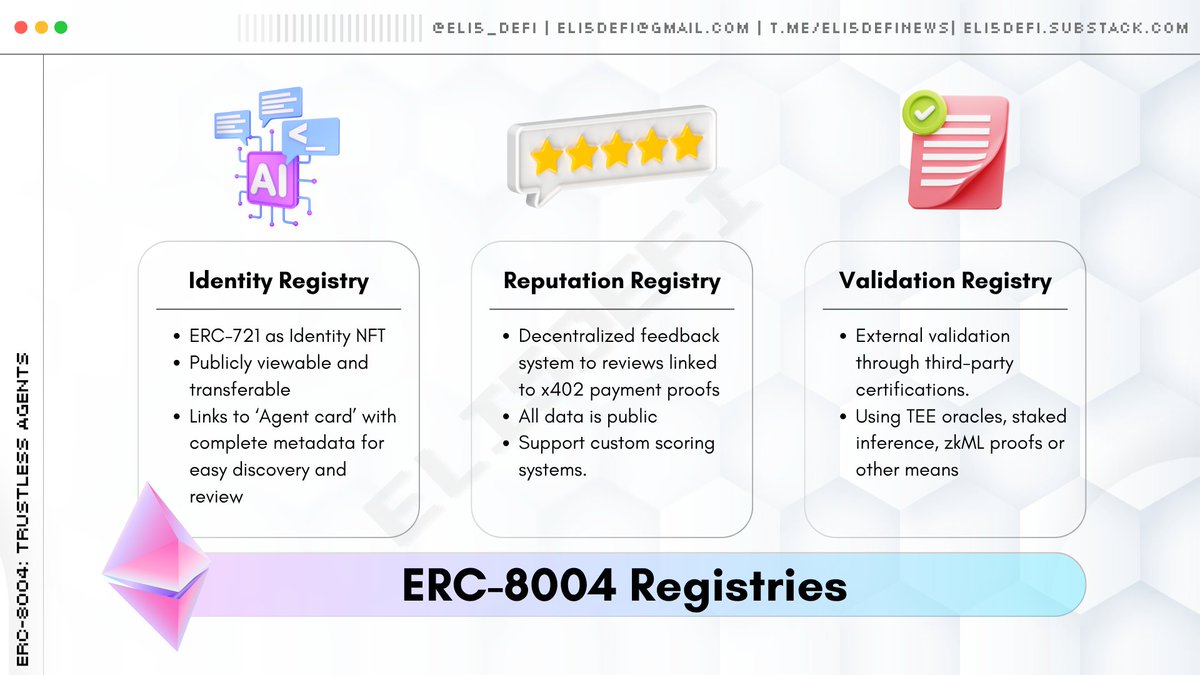The rapid evolution of AI agents, where autonomous programs that perform tasks and interact with each other, has exposed a critical gap in their ecosystem: the inability to establish trust in open, decentralized environments. While agents have become increasingly sophisticated at communicating through protocols like Google's Agent-to-Agent (A2A) framework, they lack native capabilities for identity verification, reputation tracking, and outcome validation when operating across organizational boundaries.
ERC-8004, known as the "Trustless Agents" standard, represents Ethereum's strategic solution to this challenge. By creating a decentralized trust layer on the blockchain, this groundbreaking standard enables AI agents to discover, verify, and collaborate with unfamiliar counterparts without relying on centralized intermediaries. The standard reached its stable release in October 2025, marking a significant milestone in the convergence of blockchain technology and artificial intelligence.
This article explores how ERC-8004 establishes the foundational infrastructure for a trustless AI agent economy, examining its technical architecture, real-world applications, and potential to reshape the landscape of human and machine interactions.
What Is ERC-8004?
ERC-8004 is an Ethereum Improvement Proposal that establishes three lightweight on-chain registries—Identity, Reputation, and Validation, which is to provide a trust layer for autonomous AI agents. Officially created on August 13, 2025, the standard represents a collaborative effort between industry leaders including Marco De Rossi from MetaMask, Davide Crapis from the Ethereum Foundation, Jordan Ellis from Google, and Erik Reppel from Coinbase.
The standard extends the existing A2A communication protocol by adding the missing trust components that enable agents to interact securely across organizational boundaries. While A2A solves the interoperability challenge of how agents communicate, ERC-8004 addresses the critical question of how they can trust each other without prior relationships or centralized authorities.
What sets ERC-8004 apart in the history of Ethereum standards is its unprecedented backing from both the crypto ecosystem and traditional tech giants. The Ethereum Foundation has identified it as a strategic priority, establishing a dedicated dAI team to drive its adoption. Within 24 hours of its draft release, the standard generated over 10,000 social media mentions and eight independent implementations, which is a record-breaking pace compared to previous ERC standards.
The Significance of ERC-8004
ERC-8004 arrives at a crucial juncture in both AI and blockchain development. As AI transitions from conversational tools to autonomous agents capable of performing complex tasks—from managing investment portfolios to booking travel—the limitations of centralized trust models have become increasingly apparent. Major tech companies currently control the dominant agent ecosystems, creating data silos where user identities and reputation scores cannot transfer across platforms.
The standard challenges this centralized paradigm by leveraging Ethereum's neutral, verifiable substrate to create an open agent economy. Its significance extends across multiple dimensions:
Breaking Platform Monopolies: By giving agents portable identities and reputations, ERC-8004 liberates them from platform lock-in, similar to how email protocols freed electronic communication from proprietary systems.
Establishing Machine Identity: Each agent receives a unique blockchain-based identity implemented as an ERC-721 token, creating a verifiable digital passport that cannot be arbitrarily revoked.
Creating Audit Trails: The standard maintains comprehensive records of agent interactions, performances, and validations that are transparent yet tamper-proof.
According to Tomasz Stanczak, Joint Executive Director of the Ethereum Foundation, ERC-8004 represents a core functional standard for the emerging agent economy, working alongside payment standards like EIP-2 to create a comprehensive framework for machine-to-machine interactions.
How ERC-8004 Works: The Trust Mechanism
ERC-8004's trust architecture revolves around three interconnected registries that collectively address the fundamental questions of agent interactions: "Who am I dealing with?", "Are they trustworthy?", and "Did they perform correctly?"
Identity Registry: The Blockchain Passport
ERC-8004 Registries. Source: Eli5Defi X account
The Identity Registry implements agent identities as ERC-721 tokens with URIStorage extensions. This approach provides each agent with a portable, censorship-resistant identifier while making them immediately compatible with existing NFT infrastructure.
Each identity includes:
-
AgentID: A unique blockchain identifier (ERC-721 token)
-
Token URI: Points to an agent registration file describing the agent's name, skills, and communication endpoints
-
Endpoints: Supported communication protocols including A2A, MCP, ENS, and wallet addresses
This identity framework enables permissionless discovery across suppliers and platforms, as any browser or marketplace can index the standardized profile information.
Reputation Registry: Building Trust Through Transparency
The Reputation Registry provides a standardized interface for posting and retrieving feedback on agent performance. After completing tasks, clients can submit structured feedback with scores from 0-100, optional tags categorizing the feedback, and links to detailed off-chain data.
A crucial innovation is the integration of x402 payment proofs, which verify that only paying customers can leave reviews—preventing spam and fraudulent feedback. This creates a system where economic interactions reinforce credibility, as reputation becomes tied to verifiable transactions.
Validation Registry: Ensuring Reliability
The Validation Registry introduces mechanisms for independent verification of agent performance. It provides generic hooks for requesting and recording validator checks through multiple approaches:
-
Crypto-economic staking mechanisms
-
zkML proofs for verifiable computation
-
Trusted Execution Environment (TEE) oracles
Agents can request validation by calling the validationRequest function, with validators responding with scores between 0-100 that support either binary pass/fail outcomes or spectrum evaluations. This flexibility allows the standard to accommodate different risk profiles across various applications, from casual consumer tasks to high-stakes financial or medical operations.
x402 and the ERC-8004 Ecosystem
Crypto × AI is Agentic Commerce. Source: Eli5Defi X account
While ERC-8004 establishes the trust layer for AI agents, the x402 protocol provides the complementary payment layer that enables seamless machine-to-machine transactions. Developed by Coinbase, x402 serves as an open payment channel for agents, handling micropayments, API access, and settlement without intermediaries.
The integration of these two standards creates a complete foundation for the agent economy:
This combination has already demonstrated its practical viability through implementations like the Koshin protocol, which in September 2025 showcased a complete purchasing workflow where AI agents collaboratively found and verified a green winter jacket for a customer named Charlie. The process demonstrated the dual-payment structure enabled by these standards: Charlie paid both the service provider (Agent Alice) and an independent validator (Agent Bob), receiving cryptographic quality assurance in return.
The emerging ERC-8004 ecosystem extends beyond payment infrastructure. According to ecosystem reports, over 100 companies plan to build on the protocol, with notable implementations including:
-
Phala Network: Providing TEE validation services adopted by 15 projects
-
Koshin: Offering accountability protocol SDKs with 1,200 downloads within three weeks
-
Virtuals Protocol: Deploying tens of thousands of AI agents on Ethereum/Base for decentralized AI services
Applications Beyond Finance
While financial applications represent an obvious initial use case, ERC-8004's potential extends across numerous sectors:
Decentralized AI Services Marketplaces
Platforms like Virtuals Protocol are already creating markets for AI agents specializing in legal analysis, code review, and other professional services. These marketplaces leverage ERC-8004's reputation system to help users identify high-quality providers without platform intermediation.
Cross-Organizational Automation
The standard enables secure collaboration between AI systems from different organizations, allowing companies to maintain proprietary agents while safely engaging with external agents for specific tasks. This breaks down data silos while preserving privacy and security through verifiable identity and performance metrics.
Supply Chain and IoT Integration
As physical systems become increasingly automated, ERC-8004 provides a framework for trusted device-to-device communication. The standard's validation mechanisms can confirm that automated systems perform to specification, with reputation scores reflecting historical reliability.
Content Creation and Verification
The reputation and validation registries create an infrastructure for verifiable content provenance, allowing consumers to trace media back to its source and verify its authenticity through validator networks.
Conclusion
ERC-8004 represents a fundamental shift in how we establish trust in digital interactions. By providing AI agents with portable identities, transparent reputations, and verifiable performance records, the standard creates the foundation for an open agent economy that operates without centralized control.
The timing of this innovation is particularly significant. As AI capabilities advance at an accelerating pace, the question of how to maintain accountability and trust in autonomous systems becomes increasingly urgent. ERC-8004 offers a decentralized alternative to platform-dominated models that currently characterize the digital landscape, ensuring that the emerging agent economy remains open, competitive, and aligned with user interests.
While the standard continues to evolve—with challenges around gas costs, reputation model design, and attack resistance still being addressed, its rapid adoption and extensive backing suggest it has reached critical momentum. As observed in the blockchain community, ERC-8004 has generated an unprecedented level of cross-industry collaboration, with Web3's largest wallet (MetaMask), traditional tech giants (Google), major compliant exchanges (Coinbase), and the Ethereum Foundation all aligning behind this vision for decentralized AI.
For developers, entrepreneurs, and users, understanding ERC-8004 is essential to navigating the next phase of digital transformation. Just as ERC-20 standardized tokens and ERC-721 revolutionized digital ownership, ERC-8004 has the potential to redefine how humans and machines collaborate in an increasingly automated world.
References:
CoinCatch Team
Disclaimer:
Digital asset prices carry high market risk and price volatility. You should carefully consider your investment experience, financial situation, investment objectives, and risk tolerance. CoinCatch is not responsible for any losses that may occur. This article should not be considered financial advice.



